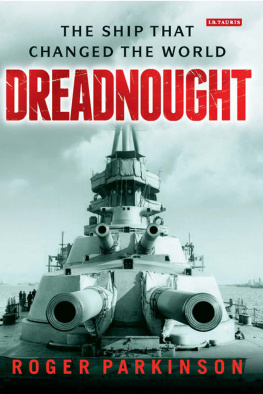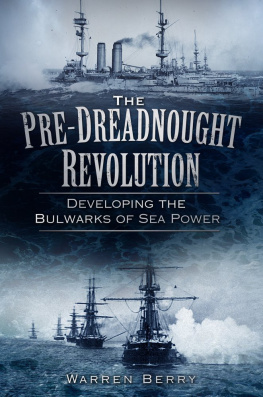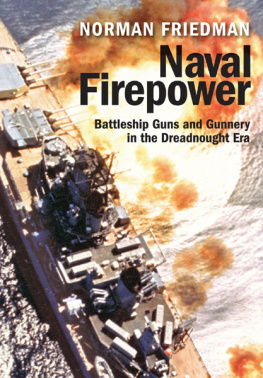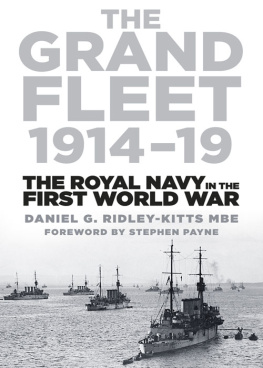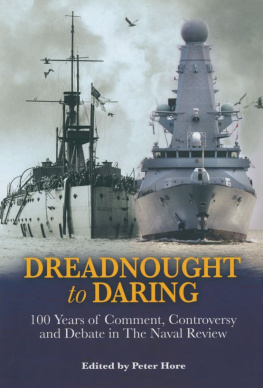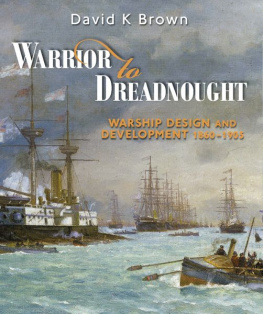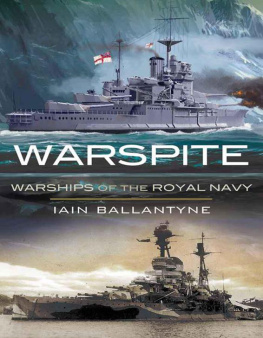Roger Parkinson is a naval historian with a PhD in Naval History fromthe University of Exeter. He is the author of The Late Victorian Navy .
An informative and readable book, it provides a useful summary of the subject,placing it in a wider context. Michael Duffy
For My Brother Oliver
19492008
Requiescat in Pace
DREADNOUGHT
The Ship that Changed the World
By
Roger Parkinson
Published in 2015 by I.B.Tauris & Co. Ltd
www.ibtauris.com
Distributed worldwide by I.B.Tauris & Co Ltd
Registered office: 6 Salem Road, London W2 4BU
Copyright 2015 Roger Parkinson
The right of Roger Parkinson to be identified as the author of this work has been assertedby the author in accordance with the Copyright, Designs and Patents Act 1988.
All rights reserved. Except for brief quotations in a review, this book, or any part thereof,may not be reproduced, stored in or introduced into a retrieval system, or transmitted, inany form or by any means, electronic, mechanical, photocopying, recording or otherwise,without the prior written permission of the publisher.
Every attempt has been made to gain permission for the use of the images in this book.Any omissions will be rectified in future editions.
References to websites were correct at the time of writing
ISBN: 9781780768267
eISBN: 9780857737052
A full CIP record for this book is available from the British Library
A full CIP record is available from the Library of Congress
Library of Congress Catalog Card Number: available
Typeset in FairfieldLH by APTARA
Contents
List of Illustrations
Figures
Plates
Preface
In a letter from Kaiser Wilhelm to Prince Von Blow dated 3 April 1909the Kaiser described British naval policy as Dreadnoughtschweinerei. Thisextraordinary word may in some sense be taken as the epitaph ofthe pre-World War I world. The years before World War I werecharacterised by intensifying Anglo-German naval competition,with an often forgotten extra-European element in the form ofthe rapidly developing navies of the United States and Japan. Inaddition the navies of France, Russia, Italy and Austria-Hungary allcontributed to the extraordinary growth of navies in the 25 years beforeWorld War I. Added to this, the naval activities, if not to say theantics, of the South American republics need close examination.Exactly how and why these navies became the centrepiece of somany different national strategies needs a careful analysis thatgoes far beyond a mere description of the Anglo-German navalbuilding race. Any contemporary analysis, especially one at thecentenary of the outbreak of World War I requires a range and depthnot often attempted before. For example the pre-dreadnought era,from the 1880s to 1906, needs most careful scrutiny and perhaps afundamental re-evaluation in terms of exactly how it influenced thesuccessor dreadnought era. An alternative title for this book mighthave been The Navalist Era in Defence 18891922 , taking this33-year period as a cohesive whole, not narrowly a history of thedreadnoughts.
From the British perspective in the annals of the Royal Navy twonames will always be linked: those of Admiral Sir John Jacky Fisher andthe ship he created, the Dreadnought . In her day, the Dreadnought was thecynosure of the early twentieth-century battleship. So epoch making wasthis one ship that all subsequent battleships are usually referred to asdreadnoughts, the name becoming a generic term. The names of Fisherand the Dreadnought are virtually synonymous, yet Fisher was notjust a product of the pre-dreadnought era but played a large partin its inception, as Captain of HMS Excellent , Director of NavalOrdnance, Third Sea Lord and Controller, Commander-in-Chief atPortsmouth, and again as Third Sea Lord and Controller. Thelate 1880s and 1890s were the years when Fisher had a decisiveinfluence on pre-dreadnought naval policy, and this needs carefulanalysis.
Arthur Marder made the case that Jacky Fisher was the man who notonly created the Dreadnought , but more or less single-handedly draggedthe Victorian and Edwardian Royal Navy kicking and screaminginto the twentieth century. Marder stated the following:
In realitythe British Navy at the end of the nineteenth century had run ina rut for nearly a century. Though numerically a very imposingforce, it was in certain respects a drowsy, inefficient, moth-eatenorganism.
An alternative view might suggest that the Victorian Royal Navy wasindeed not a war-ready navy that was not its strategic purpose; it wasthe Royal Navy of the Pax Britannica, a peacekeeping deterrent force.Marder never distinguished between a war-ready navy and a peacekeepingdeterrent force and in consequence muddled the two and missed thepoint.
The pre-dreadnought era is usually taken to end abruptly in 1906, withthe launching of HMS Dreadnought . The Dreadnought herself is moreoften than not considered revolutionary and an enormous advance over allprevious types. The truth is somewhat different; every piece of technologythat made the Dreadnought possible came out of the pre-dreadnought eraand that included steam turbines. The case will be made that thetransition from pre-dreadnoughts to dreadnoughts was a much smootherand more evolutionary process than has been generally realised. It willbe argued that Fisher and his wonder ship were the logical endproducts of the development of navies in the Victorian and Edwardianworld.
The use of the term pre-dreadnought has its own problems. Those wholived through the period 1889 to 1906 did not know it would be labelledthe pre-dreadnought era and that this was the prelude to the dreadnoughtera and World War I. Retrospective labelling can be dangerous anddistorting. As a prelude it is often assumed that the pre-dreadnought erais less important than the dreadnought era that followed it andhas received less consideration from historians as a result. Wherehistorians have written about the pre-dreadnought period, theyhave usually taken the Naval Defence Act of 1889 as their startingpoint.
The Dreadnought owed a great deal to the naval war between Japanand Russia, fought in the Far East, 19035. In the case of the firstbattlecruisers, they were a direct reply to the large numbers ofarmoured cruisers built by France and clearly identifiable as commerceraiders in any future war. The battlecruisers were the rapid reactionforce of the early twentieth century. Equipped with radio, theycould go anywhere and deal with any armoured cruiser built orprojected, but the ententes with France and later Russia ratherinvalidated the early battlecruiser concept. This was also the age of thelarge, fast Atlantic liner. Germany had a number of these ships andthere was a fear they might be used as armed merchant cruisers inwartime.
It was only after 1905 and the first Morocco crisis that Germanybecame identified as the primary threat to Britains maritime supremacy.Two classes of British dreadnoughts followed, totalling six ships but in1909 matters came to a head. Successive attach reports from Berlinsuggested an acceleration in German building programmes. Britain reactedwith eight dreadnoughts laid down in one year and seven the next.An era of intensifying naval competition became a full-bloodednaval arms race. It was an arms race defined by the move fromdreadnoughts to super-dreadnoughts. America and Japan participatedin full and both countries overtook France and Russia as navalpowers of the first rank. In the Mediterranean, Austria-Hungaryand Italy built against each other in their own naval arms race. InSouth America, Brazil, Argentina and Chile produced their ownhighly idiosyncratic naval arms race. By 1914 the dreadnoughtfever had raged around the world. Britain won the building racewith Germany, but by a narrower margin than might have beenexpected.

